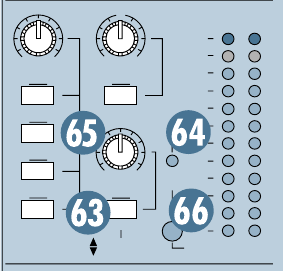
24
MODE (NORMAL (AFL)/LEVEL SET (PFL))
You may have already seen this, but in case
you missed it: The CR1604-VLZ’s solo system
comes in two flavors:
NORMAL (AFL)
(sometimes
called SIP, or solo-in-place) and
LEVEL SET (PFL)
(sometimes called PFL, or pre-fader-listen).
In
NORMAL (AFL)
, the soloed
channel’s signal is sent directly to
the
C-R OUTS
,
PHONES
output
and meter
display just as it would
sound to the channel’s assign-
ment switches: post-
EQ
,
post-fader and post-
PAN
. The
only difference is that
SOLO
works regardless of the channel’s
assignment
positions, and that
makes it really handy — you can
check out a channel before you assign it.
NORMAL (AFL)
is the preferred mode dur-
ing mixdown: If the channel has some
midrange boost at 4.236kHz, is panned a smid-
gen to the left, and its fader is at –5.385dB,
that’s exactly what you’ll hear if you
SOLO
dur-
ing
NORMAL (AFL)
mode. It’s just as if you
took the time to
MUTE
all the other channels.
LEVEL SET (PFL)
solo is the key player in the
all-important
Level-Setting Procedure
. It’ll
send the channel’s actual internal levels to the
meters so you’ll know just what’s going on, level-
wise. This procedure should be performed every
time a new sound source is patched into a
channel’s
MIC
or
LINE
input jacks.
LEVEL SET (PFL)
is also the preferred mode
for SR (sound reinforcement, or live sound), to
preview channels before they are let into the
mix. It won’t give you stereo placement, but will
give you signal even if the fader is turned down.
Remember,
LEVEL SET (PFL)
taps the chan-
nel signal before the fader. If you have a
channel’s fader set way below “
U
” (unity gain),
SOLO
won’t know that and will send a unity
gain signal to the
C-R OUTS
,
PHONES
output
and meter
display. That may result in a star-
tling level boost at these outputs, depending
on the position of the
SOLO
level knob .
LEVEL SET LED
To quote step 6 of the
Level-Setting
Procedure
, “Push in the
MODE
switch in
the output section (
LEVEL SET (PFL)
mode)
— the
LEVEL SET
LED will light.” When the
solo
MODE
switch is engaged, it’s in
LEVEL
SET (PFL)
mode, the mode you must be in to
set levels. Now, when you engage any solo
switch, this LED will be a “green light” to set
levels. If you tried to set levels during
NORMAL (AFL)
mode, the meter
display
would be at the mercy of the channel fader,
and that would be a big problem.
SOLO (LEVEL)
This knob controls the level of the signals
coming from the
SOLO
system. It’s range is off
when fully down, unity at the center detent,
with 10dB additional gain turned fully up. After
the
SOLO
level is determined, the
SOLO
signals
will proceed to take over the
C-R OUTS
,
PHONES
output and meter display .
Once again,
LEVEL SET (PFL) SOLO
taps
the channel signal before the fader. If you
have a channel’s fader set way below “
U
”
(unity gain),
LEVEL SET (PFL) SOLO
won’t
know that and will send a unity gain signal to
the
C-R OUTS
,
PHONES
output and meter
display. That may result in a startling level
boost at these outputs, depending on the
position of the
SOLO
level knob.
RUDE SOLO LIGHT
This flashing LED (light emitting diode)
serves two purposes — to remind you that
you’re in
SOLO
, and to let you know that
you’re mixing on a Mackie. No other company
is so concerned about your level of
SOLO
awareness. We even force the soloed chan-
nel’s
–20
LED to play along, so you can find
that rogue switch fast.
If you work on a mixer that has a
SOLO
function with no indicator lights, and you
happen to forget you’re in
SOLO
, you can eas-
ily be tricked into thinking that something is
wrong with your mixer. Hence the
RUDE
SOLO LIGHT
. It’s especially handy at about
3:00 in the morning, when no sound is coming
out of your monitors, even though your multi-
track is playing back like mad.
LEFT RIGHT
TAPE IN
SOLO
RUDE
SOLO
LIGHT
C
-
R / PHONES
SUBS 3
–
4
SUBS 1
–
2
MAIN MIX
SOURCE
TAPE
TAPE TO
MAIN MIX
28
CLIP
10
7
4
2
2
0
4
7
10
20
30
LEVEL
SET
MODE
(AFL)
LEVEL SET
NORMAL
(PFL)
U
OO
+20
OO
OO
MAX
0 dB=0 dBu
MAX


















